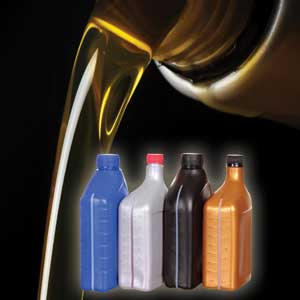
Few debates among bikers can match the intensity of the one over motor oil selection. Online forums are filled with spirited defenses of particular brands and types of oil, specifically conventional versus synthetic. Criticize someone’s choice of oil and watch the firestorm ensue.
Since motorcycles can be brutal on oil, it pays to know some basics about the lubricant to help your customers keep their expensive engines from failing. Enough hard data and anecdotal evidence now exists to have convinced most bikers of synthetics’ superiority. But even for those who religiously use synthetic motorcycle oil, what exactly makes it different than conventional motorcycle oil is still a mystery.
As with most consumer goods, the difference simply boils down to the quality of the ingredients. Since synthetics cost more off the shelf, you can quickly figure out which type of oil contains better ingredients. Conventional and synthetic motorcycle oil contains two basic components: base oils and additives. Although the finished product that goes in a bike is amber or brownish in color, base oils are actually clear, like water. Their quality determines a number of key performance properties, including oxidative stability (the ability to resist chemical breakdown), heat resistance, viscosity retention (the ability to resist thinning) and pour point (fluidity at low temperatures). The goal in manufacturing base oils is a molecularly uniform, pure substance. Why? Because inconsistency and impurities limit performance. Additives in the final motor oil formulation offer specific performance features not provided by base oils, like the ability to resist corrosion that may form when bikes are in storage.
The base oils used in conventional oils are anything but uniform and pure. They are refined from crude oil pumped from within the earth, which is a poor lubricant in and of itself; it’s a thick, messy, foul-smelling raw material teeming with molecules of different weights. Sulfur, paraffin (wax), nitrogen, oxygen and nickel are just some of the molecules in crude harmful to the lubricating process. Paraffin, for example, thickens as the temperature drops, making it more difficult to start your motorcycle on a cold morning and inhibiting the oil’s ability to quickly flow to critical engine parts. It’s no coincidence the majority of engine wear occurs at start up. Impurities cause the oil to oxidize sooner — in layman’s terms, break down — requiring it to be changed. That’s just one reason conventional oils reach the end of their useful service lives sooner than synthetics.
Six Differences Between Motorcycle and Automotive Applications
Every once in a while, someone wants to know why they can’t just put regular motor oil in their motorcycle. The short answer is that oils are formulated for specific applications. Motorcycle engines and automobile engines function differently, and the lubricants that service them have different requirements. Here are the six primary differences between motorcycle and automotive engine applications.
1. Operational Speed. Motorcycles tend to operate at engine speeds significantly higher than automobiles. This places additional stress on engine components, increasing the need for wear protection. It also subjects lubricating oils to higher loading and shear forces. Elevated operating RPMs also promote foaming, which can reduce an oil’s load-carrying ability and accelerate oxidation.
2. Compression Ratios. Motorcycles tend to operate with higher engine compression ratios than automobiles. Higher compression ratios place additional stress on engine components and increase engine operating temperatures. Higher demands are placed on the oil to reduce wear. Elevated operating temperatures also promote thermal degradation of the oil, reducing its life expectancy and increasing the formation of internal engine deposits.
3. Horsepower/Displacement Density. Motorcycle engines produce nearly twice the horsepower per cubic inch of displacement as automobile engines. This exposes the lubricating oil to higher temperatures and stress.
4. Variable Engine Cooling. In general, automotive applications use a sophisticated water-cooling system to control engine operating temperature. Similar systems can be found in motorcycle applications, but other designs also exist. Many motorcycles are air-cooled or use a combination air/oil design. Though effective, they result in greater fluctuations in operating temperatures, particularly when motorcycles are operating in stop-and-go traffic. Elevated operating temperature promotes oxidation and causes oils to thin, reducing their load carrying ability.
5. Multiple Lubrication Functionality. In automotive applications, engine oils are required to lubricate only the engine. Other automotive assemblies, such as transmissions, have separate fluid reservoirs that contain a lubricant designed specifically for the component. The requirements of that fluid differ significantly from those of automotive engine oil. Many motorcycles have a common sump supplying oil to both the engine and transmission. In such cases, the oil is required to meet the needs of both the engine and the transmission gears. Many motorcycles also incorporate a frictional clutch within the transmission that uses the same oil.
6. Inactivity. Motorcycles are typically used less frequently than automobiles. Whereas automobiles are used on a daily basis, motorcycle use is usually periodic and in many cases seasonal. These extended periods of inactivity place additional stress on motorcycle oils. In these circumstances, rust and acid corrosion protection are of critical concern.
Although the refining process removes some of the molecular inconsistency and impurities from conventional base oils, it can’t get them all. A barrel of crude oil contains a mix of various hydrocarbons and impurities. The most common method of separating the crude into useful components (called fractions) is to apply heat until each fraction condenses. The process yields several products we use every day, including gasoline, LPG, kerosene and, yes, base oils used to manufacture finished conventional motorcycle oils. Although the refining process has served us well for decades, it has its limitations. The conventional base oils produced are inconsistent at the molecular level and contain impurities that reduce performance.
For example, their ability to resist heat suffers. Have you ever checked an oil level and found it low even though the bike doesn’t leak oil? Chances are the oil volatilized, or literally boiled off. The effects of highly volatile conventional oils are especially noticeable in high-displacement, air-cooled bikes operating at the height of summer. The elevated heat results in evaporation, causing the oil level to drop. Some of the oil exits the exhaust pipe as emissions; some vaporizes into harmful deposits that form on critical engine parts, like the spark plugs, piston crowns and exhaust valves. In a matter of time, poor performance can set in, resulting in reduced efficiency and difficult starts.
Just as problematic, conventional oils are more prone to losing viscosity due to mechanical shear. Viscosity is one of the most important features of oil, and an engine is designed to run on oil with a specific viscosity. The churning action of high-rpm engine parts and transmission gears, coupled with elevated heat, can literally tear apart, or shear, the molecular structure of the oil, particularly the unstable molecules in conventional oils. As a result, the oil loses viscosity and becomes thinner. Suddenly, the 20W-50 oil installed becomes a 40-weight oil, which fails to meet the viscosity requirements a motorcycle engine needs for maximum wear protection.
While refining is only capable of limiting impurities and molecular differences in base oils, the chemical reaction process used to manufacture synthetic base oils produces molecularly uniform, pure base oils. In short, a better ingredient. As you’d suspect, synthetics demonstrate increased resistance to heat and mechanical shear compared with their conventional counterparts. By engineering lubricants with synthetic base oils that contain uniform molecules and no impurities, manufacturers can tailor their formulations to address the problems posed by powerful, hot-running bikes, like high heat and mechanical shear. The end product simply performs better.
So, while the debate over which brand of oil to use will surely rage on, the debate over which type of oil to use is largely settled once you understand what makes synthetics different. As bike manufacturers continue squeezing the greatest amount of power and efficiency out of smaller engines, the challenges of elevated heat and shearing conditions will only worsen. Not only that, but what biker doesn’t want more power and maximum fuel efficiency? Synthetics’ uniformity reduces friction compared to conventional oils, often resulting in a slight bump in horsepower and fuel economy.
Conventional oils are limited in the level of performance they can provide. For that matter, so are synthetic blend oils, which combine an undisclosed percentage of synthetic base oils with conventional base oils. They served us well for years, but their time has come. In fact, while sales of conventional oils have stagnated recently, synthetics continue attracting new and loyal users. Synthetics represent possibly the least expensive long-term investment you can make in the performance and longevity of your motorcycle.













